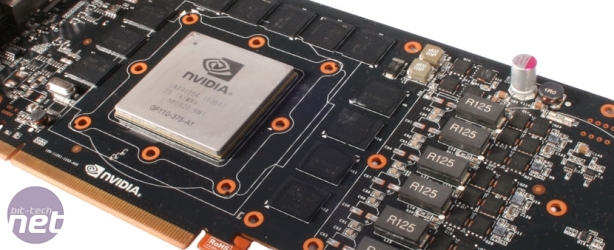
A Stable GeForce GTX 580 Overclock
After the flakiness of our previous overclocking attempt, we dropped down our overclock in stages until the card was happy churning through Just Cause 2 for a prolonged period. Eventually we settled on a 860MHz GPU core frequency, 1,720MHz stream processor clock and a 1.05GHz (4.2GHz effective) memory frequency. At these settings our overclock proved rock solid and gave an appreciable performance boost too, netting us an extra 7fps at 1,920 x 1,200 with no AA. Admittedly, the average frame rate didn’t see quite as much of a boost, raising by only 3fps whether AA was enabled or not.These boosts brought the GTX 580 1.5GB closer to the Radeon HD 5970 2GB in this particular game, closing the gap with AA disabled to 2fps and overtaking the ATI card by 3fps with 4x AA enabled. This is a solid result, especially in a game that enjoys working with dual GPUs. In other games, the GTX 580 1.5GB is already faster than the massive HD 5970 2GB, so the overclock makes it even faster.
The new vapour chamber cooler of the GTX 580 1.5GB was pleasingly quiet during our testing, though it was louder than when we tested the card at stock speeds. Its fan span up to only around 54 per cent of its potential speed. This kept the GPU peak temperature to a hot-but-not-excessive 70oC, which was 47oC above the ambient temperature of the room. This is actually cooler than the GPU was at stock speed (by 8oC), so the overclock must have pushed the GPU beyond a fan management threshold.
Conclusion
So what does all this mean? Well, in the short term it means that we’re likely to see overclocked GTX 580 cards out there, though it’ll be interesting to see whether partners will choose to stick with the capable stock cooler or differentiate their card with a custom cooler.Reading into this a little more though, it likely means that yields on the GF110 chip should good; given that there is so much performance in reserve. While the GF110 is a large chip with a new manufacturing method and so is unlikely to be in overwhelming supply for a while, there shouldn't be horrendous stocking issues. This should mean that there's plenty of competition between the board partners, keeping prices keen for consumers.
Looking to the future, we can further speculate that Nvidia is well placed to deal with ATI’s forthcoming HD 6900-series of cards. If it turns out these cards soundly thrash a GTX 580, then it wouldn’t be too challenging for Nvidia to release an overclocked GXT 580 card and call it a GTX 585 - the GF110 and its cooler could easily take a 50-65MHz clock bump in their stride.
The overclockability of the GF110 also bodes well for the flexibility of Nvidia’s future 5-series cards. There's no guarantee that just because the top-end GPU overclocks well, the mid-range ones will too, but the overclocking headroom that we've indicates that Nvidia and TSMC have nailed the new manufacturing method that we'd expect from the rest of the GeForce 500 range. Just as 2010 was tinted a shade of red, 2011 could well be very green.

MSI MPG Velox 100R Chassis Review
October 14 2021 | 15:04









Want to comment? Please log in.